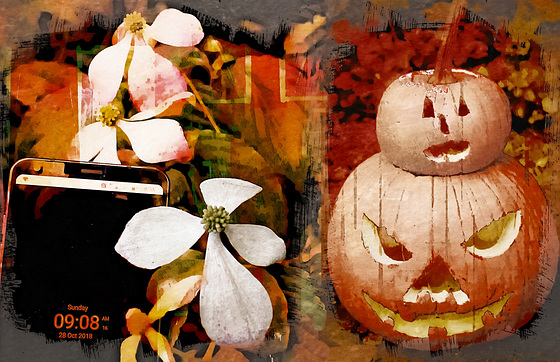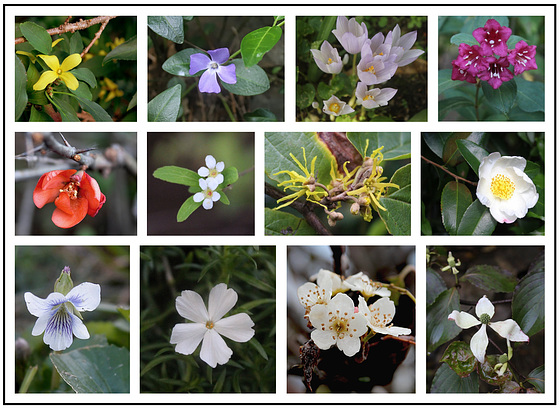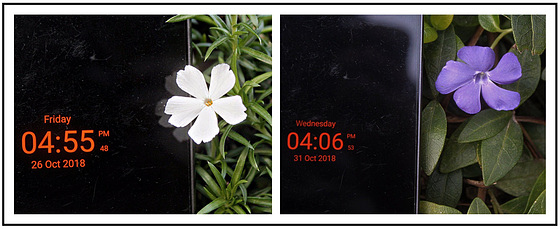This year after a wet, tropical-like hot summer followed by Indian Summer in much of September, the spring before Halloween was present for all who sought it in the New York City metro area despite brilliant reds, oranges and yellows that drew attention and thick canopies of leaves that concealed the off-season blooms. It is as if the Jack O’ Lanterns played a seasonal trick with spring flora and gave us an April-like treat this October.
In the late 19th century, poet Mary Clemmer wrote, “The Indian Summer, the dead Summer’s soul, [c]omes back with more than the first loveliness…” in Poems of Life and Nature, Third Edition (Boston, Ticknor and Company, 1886, 151-152). As climate change takes hold with more pronounced periods of warmth and plants are adopting biannual flowering patterns, there is some truth to her saying when one considers spring represents renewal and plants that used to exclusively flower in the spring are also experiencing off-season blooms often in late autumn and parts of winter, though not this early as has occurred in 2018.
October 2018 in the New York City metro area can now be added to the list of anomalous months when such botanical events are considered. After a wet summer with above average temperatures (July 1.1° F, August 2.9° F, September 2.7° F, October 0.7° F above normal, respectively; July 2.85”, August 4.15”, and September 1.91” above normal precipitation, respectively) followed by a brief period of below normal temperatures and drier conditions in October (0.80” below normal precipitation), some plants due to altered biological clocks, in which stress is unlikely to have played a material role, have been tricked into believing spring has arrived resulting in record early blooms as nature pushes the limits.
Spring-beauty crocuses, not to be mistaken with autumn crocuses that have distinct morphological and anatomical differences from their spring cousins – autumn crocuses are larger in size, have longer stems and do not engage in photonastic movement (open and close based on non-directional light based on short-term changes in light intensity, which in short means they remain open at all times unlike spring crocuses that open during the day when sufficient sunlight is present and close especially during periods of darkness from dusk to dawn) – have been present in Mamaroneck, NY for the entire month since October 19th.
In addition, forsythia that first emerged on October 10th have been blooming in abundance throughout the area – New Rochelle, Larchmont, Mamaroneck, and White Plains, NY to name a few areas. Periwinkles have been present in Larchmont and Mamaroneck, NY since October 13th. By October 25th a Weglia Red Prince bush in Mamaroneck, NY that typically blooms from April to June had produced a cluster of five flowers. Violets and phlox had emerged also in Mamaroneck, NY on October 25th and 26th, respectively.
While the presence of blooming violets had been recorded in Indiana in October 2012, no such documentation exists for the New York City metro area with records dating back to the 1770s. Prior to this year, the earliest mentioned violet blooms in the New York City metro area had been mid-to-late November and December.
A good friend, who often writes to me, said one day last week that she was surprised to have discovered violets in her yard. “Imagine that,” she wrote, “Violets in October.” But I didn’t have to imagine it; as I pushed a mower along a hillside near my flower garden the very evening I got her note, I saw perfectly purple little violets growing there, too.[1]
At the same time, Baby’s Breath Spirea and Quince also began to blossom in Central Park Garden, New York, NY on October 21st, while a witch hazel bush at the New York Botanical Garden (NYBG), Bronx, NY had numerous blossoms and two tea-oil camellia bushes at NYBG that generally bloom from mid-to-late February through May at the latest, had an abundance of flowers, also on October 21st.
A cluster of four cherry blossoms was also observed blooming in White Plains, NY on October 28th, while a Kousa dogwood tree in Irvington, NY (known as the ”Fieldpoint Kousa” because of its location and newspaper coverage in December 2010 when it exhibited a full bloom) that has found it increasingly advantageous to bloom biannually had an abundance of blossoms on this same date. Considering this tree consisted of multiple fully mature bracts and such bracts take between 14-21±3 days to mature, it is likely it began to flower anywhere between October 4th and 17th.
Also consistent with findings on December 5 and 6, 2010 and November 12, 2011, some of this Kousa dogwood’s blossoms exhibited spotty, cold-induced brilliant pink inflorescence since the temperature fell into the low 30s F on several nights in October.
Last, as climate change continues resulting in changes in bloom patterns for various flora, adaptability and rapid recovery will be key in deciding which plants will thrive and which plants will be doomed to endangerment or even extinction. If they can adapt taking advantage of biannual pollination and exhibit rapid recovery such that they do not squander precious reserve supplies of nutrients they will be well suited for the climatological changes of the 21st century and beyond. If their biannual blooms result in insufficient pollination such that the cost of autumn/winter blossoming outweighs the benefits gained, they may not have the necessary nutrients to engage in rapid recovery and will find climate change difficult or even impossible to deal with.
Top left to right: Forsythia (October 10, 2018 Mamaroneck, NY), Periwinkle (October 13, 2018 Larchmont, NY), Spring Beauty Crocuses (October 19, 2018 Mamaroneck, NY), and Weglia Red Prince (October 25, 2018 Mamaroneck, NY)
Middle left to right: Quince and Baby’s Breath Spirea (October 21, 2018 Central Park Garden, New York, NY) and Witch Hazel and Camellia (October 21, 2018 New York Botanical Garden, Bronx, NY)
Bottom left to right: Violet (October 25, 2018 Mamaroneck, NY), Phlox (October 26, 2018 Mamaroneck, NY), Cherry Blossoms (October 28, 2018 White Plains, NY) and Kousa Dogwood Blossoms (October 28, 2018 Irvington, NY)
Sample Dated Photos:
___________
[1] Mike Lunsford. Violets in October – a pleasant surprise. Tribune-Star. 15 October 2012. www.tribstar.com/news/local_news/mike-lunsford-violets-in-october-a-pleasant-surprise/article_0212d46c-ee18-5e8a-a63f-d510dda05d01.html
In the late 19th century, poet Mary Clemmer wrote, “The Indian Summer, the dead Summer’s soul, [c]omes back with more than the first loveliness…” in Poems of Life and Nature, Third Edition (Boston, Ticknor and Company, 1886, 151-152). As climate change takes hold with more pronounced periods of warmth and plants are adopting biannual flowering patterns, there is some truth to her saying when one considers spring represents renewal and plants that used to exclusively flower in the spring are also experiencing off-season blooms often in late autumn and parts of winter, though not this early as has occurred in 2018.
October 2018 in the New York City metro area can now be added to the list of anomalous months when such botanical events are considered. After a wet summer with above average temperatures (July 1.1° F, August 2.9° F, September 2.7° F, October 0.7° F above normal, respectively; July 2.85”, August 4.15”, and September 1.91” above normal precipitation, respectively) followed by a brief period of below normal temperatures and drier conditions in October (0.80” below normal precipitation), some plants due to altered biological clocks, in which stress is unlikely to have played a material role, have been tricked into believing spring has arrived resulting in record early blooms as nature pushes the limits.
Spring-beauty crocuses, not to be mistaken with autumn crocuses that have distinct morphological and anatomical differences from their spring cousins – autumn crocuses are larger in size, have longer stems and do not engage in photonastic movement (open and close based on non-directional light based on short-term changes in light intensity, which in short means they remain open at all times unlike spring crocuses that open during the day when sufficient sunlight is present and close especially during periods of darkness from dusk to dawn) – have been present in Mamaroneck, NY for the entire month since October 19th.
In addition, forsythia that first emerged on October 10th have been blooming in abundance throughout the area – New Rochelle, Larchmont, Mamaroneck, and White Plains, NY to name a few areas. Periwinkles have been present in Larchmont and Mamaroneck, NY since October 13th. By October 25th a Weglia Red Prince bush in Mamaroneck, NY that typically blooms from April to June had produced a cluster of five flowers. Violets and phlox had emerged also in Mamaroneck, NY on October 25th and 26th, respectively.
While the presence of blooming violets had been recorded in Indiana in October 2012, no such documentation exists for the New York City metro area with records dating back to the 1770s. Prior to this year, the earliest mentioned violet blooms in the New York City metro area had been mid-to-late November and December.
A good friend, who often writes to me, said one day last week that she was surprised to have discovered violets in her yard. “Imagine that,” she wrote, “Violets in October.” But I didn’t have to imagine it; as I pushed a mower along a hillside near my flower garden the very evening I got her note, I saw perfectly purple little violets growing there, too.[1]
At the same time, Baby’s Breath Spirea and Quince also began to blossom in Central Park Garden, New York, NY on October 21st, while a witch hazel bush at the New York Botanical Garden (NYBG), Bronx, NY had numerous blossoms and two tea-oil camellia bushes at NYBG that generally bloom from mid-to-late February through May at the latest, had an abundance of flowers, also on October 21st.
A cluster of four cherry blossoms was also observed blooming in White Plains, NY on October 28th, while a Kousa dogwood tree in Irvington, NY (known as the ”Fieldpoint Kousa” because of its location and newspaper coverage in December 2010 when it exhibited a full bloom) that has found it increasingly advantageous to bloom biannually had an abundance of blossoms on this same date. Considering this tree consisted of multiple fully mature bracts and such bracts take between 14-21±3 days to mature, it is likely it began to flower anywhere between October 4th and 17th.
Also consistent with findings on December 5 and 6, 2010 and November 12, 2011, some of this Kousa dogwood’s blossoms exhibited spotty, cold-induced brilliant pink inflorescence since the temperature fell into the low 30s F on several nights in October.
Last, as climate change continues resulting in changes in bloom patterns for various flora, adaptability and rapid recovery will be key in deciding which plants will thrive and which plants will be doomed to endangerment or even extinction. If they can adapt taking advantage of biannual pollination and exhibit rapid recovery such that they do not squander precious reserve supplies of nutrients they will be well suited for the climatological changes of the 21st century and beyond. If their biannual blooms result in insufficient pollination such that the cost of autumn/winter blossoming outweighs the benefits gained, they may not have the necessary nutrients to engage in rapid recovery and will find climate change difficult or even impossible to deal with.
Middle left to right: Quince and Baby’s Breath Spirea (October 21, 2018 Central Park Garden, New York, NY) and Witch Hazel and Camellia (October 21, 2018 New York Botanical Garden, Bronx, NY)
Bottom left to right: Violet (October 25, 2018 Mamaroneck, NY), Phlox (October 26, 2018 Mamaroneck, NY), Cherry Blossoms (October 28, 2018 White Plains, NY) and Kousa Dogwood Blossoms (October 28, 2018 Irvington, NY)
Sample Dated Photos:
[1] Mike Lunsford. Violets in October – a pleasant surprise. Tribune-Star. 15 October 2012. www.tribstar.com/news/local_news/mike-lunsford-violets-in-october-a-pleasant-surprise/article_0212d46c-ee18-5e8a-a63f-d510dda05d01.html




9 comments
Stormlizard said:
Amelia said:
William Sutherland replied to Amelia:
William Sutherland said:
* ઇઉ * said:
An impressive documentary, William.
William Sutherland replied to * ઇઉ *:
* ઇઉ *,
Autumn violets are still a rarity here in the Northeast in autumn and meteorological winter (December thru February). In fact the violet I photographed, the Canada Violet typically blooms in May (http://www.centralparknyc.org/things-to-see-and-do/bloom-guide/blooms/canada-violet.html?season=). I've seen them often bloom in late April. They have also been documented to have had anomalous blooms in late November, December, January, and February but rarely. Here in NY, never in October based on records that date back to the 1770s.
Perhaps in your part of the world you have a slightly different climate such as warmer winters that might account for this.
Peggy C said:
Waiting to see if the Jane Tulip begins blooming again next door .. it has already bloomed twice.. 1st time before snow - then in Spring/Summer...
His Buddleja is still going great - mine is done.
Forsythia bushes are blooming across the street ..
* ઇઉ * replied to :
William Sutherland said:
I'll have to check if white lilac is blooming in my area. I've seen something since late October that looks like a white butterfly bush but it could be white lilac. As it's on private property, I'll need my zoom lens to get more details. Yes, it appears forsythia are fast becoming a biannual blooming plant. Thanks for taking notice since the dark leaves can often hide the blossoms.
November 2, 2018 Canada Violets have sprung up in two additional locations and forsythia and periwinkles continue to be widespread with two days of 70F warmth.
November 3, 2018 Crocus blooms are coming to a natural end exhibiting typical end of bloom dessication. Periwinkles and forsythia remain in an abundance. Another Kousa Dogwood tree has been found blooming in Larchmont, NY. Unlike typical Kousa Dogwood bracts that are white in color, these blossoms are all pink further confirming the fact a recessive gene for pink pigmentation can be activated by temperatures that fall into the 30s F. Also because of the last few days significantly above average warmth, a Chinese Flowering Crab Apple tree that typically blooms here in the New York City metro area between April and May, is now blossoming.
Kousa Dogwood, Larchmont, NY -- November 3, 2018
Chinese Flowering Crab Apple, Larchmont, NY -- November 3, 2018
Forsythia, Mamaroneck (top left) and Larchmont, NY (bottom left and right) -- November 3, 2018